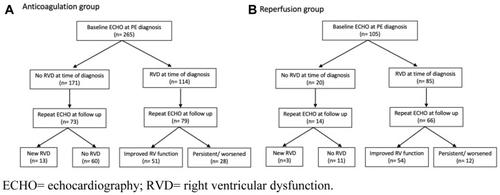当前位置:
X-MOL 学术
›
J. Vasc. Surg. Venous Lymphatic Disord.
›
论文详情
Our official English website, www.x-mol.net, welcomes your feedback! (Note: you will need to create a separate account there.)
Impact of reperfusion therapies on clot resolution and long-term outcomes in patients with pulmonary embolism
Journal of Vascular Surgery: Venous and Lymphatic Disorders ( IF 3.2 ) Pub Date : 2024-02-16 , DOI: 10.1016/j.jvsv.2024.101823 Ka U. Lio , Riyaz Bashir , Vladimir Lakhter , Si Li , Joseph Panaro , Parth Rali
Journal of Vascular Surgery: Venous and Lymphatic Disorders ( IF 3.2 ) Pub Date : 2024-02-16 , DOI: 10.1016/j.jvsv.2024.101823 Ka U. Lio , Riyaz Bashir , Vladimir Lakhter , Si Li , Joseph Panaro , Parth Rali

|
Major progress in reperfusion strategies has substantially improved the short-term outcomes of patients with pulmonary embolism (PE), however, up to 50% of patients report persistent dyspnea after acute PE. A retrospective study of the PE response team registry and included patients with repeat imaging at 3 to 12 months. The primary outcome was to determine the incidence of residual pulmonary vascular obstruction following acute PE. Secondary outcomes included the development of PE recurrence, right ventricular (RV) dysfunction, chronic thromboembolic pulmonary hypertension, readmission, and mortality at 12 months. A total of 382 patients were included, and 107 patients received reperfusion therapies followed by anticoagulation. Patients who received reperfusion therapies including systemic thrombolysis, catheter-directed thrombolysis, and mechanical thrombectomy presented with a higher vascular obstructive index (47% vs 28%; < .001) and signs of right heart strain on echocardiogram (81% vs 43%; < .001) at the time of diagnosis. A higher absolute reduction in vascular obstructive index (45% vs 26%; 95% confidence interval, 14.0-25.6; < .001), greater improvement in RV function (82% vs 65%; = .021), and lower 12-month mortality rate (2% vs 7%; = .038) and readmission rate (33% vs 46%; = .031) were observed in the reperfusion group. No statistically significant differences were found between groups in the development of chronic thromboembolic pulmonary hypertension (8% vs 5%; = .488) and PE recurrence (8% vs 6%; = .646). We observed a favorable survival and greater improvement in clot resolution and RV function in patients treated with reperfusion therapies.
中文翻译:

再灌注治疗对肺栓塞患者血栓溶解和长期结局的影响
再灌注策略的重大进展显着改善了肺栓塞 (PE) 患者的短期预后,然而,高达 50% 的患者报告急性 PE 后出现持续性呼吸困难。对 PE 反应小组登记的一项回顾性研究,包括 3 至 12 个月时重复成像的患者。主要结果是确定急性肺栓塞后残余肺血管阻塞的发生率。次要结局包括 PE 复发、右心室 (RV) 功能障碍、慢性血栓栓塞性肺动脉高压、再入院和 12 个月时的死亡率。总共纳入了 382 名患者,其中 107 名患者接受了再灌注治疗和抗凝治疗。接受再灌注治疗(包括全身溶栓、导管定向溶栓和机械血栓切除术)的患者表现出较高的血管阻塞指数(47% vs 28%;< 0.001),超声心动图显示右心劳损体征(81% vs 43%;< 0.001)。 < .001) 在诊断时。血管阻塞指数绝对降低幅度更大(45% vs 26%;95% 置信区间,14.0-25.6;< .001),右心室功能改善更大(82% vs 65%;= .021),并且 12-在再灌注组中观察到月死亡率(2% vs 7%;= .038)和再入院率(33% vs 46%;= .031)。在慢性血栓栓塞性肺动脉高压(8% vs 5%;= .488)和肺栓塞复发(8% vs 6%;= .646)方面,各组之间没有发现统计学上的显着差异。我们观察到接受再灌注治疗的患者生存率良好,血栓溶解和右心室功能有更大改善。
更新日期:2024-02-16
中文翻译:

再灌注治疗对肺栓塞患者血栓溶解和长期结局的影响
再灌注策略的重大进展显着改善了肺栓塞 (PE) 患者的短期预后,然而,高达 50% 的患者报告急性 PE 后出现持续性呼吸困难。对 PE 反应小组登记的一项回顾性研究,包括 3 至 12 个月时重复成像的患者。主要结果是确定急性肺栓塞后残余肺血管阻塞的发生率。次要结局包括 PE 复发、右心室 (RV) 功能障碍、慢性血栓栓塞性肺动脉高压、再入院和 12 个月时的死亡率。总共纳入了 382 名患者,其中 107 名患者接受了再灌注治疗和抗凝治疗。接受再灌注治疗(包括全身溶栓、导管定向溶栓和机械血栓切除术)的患者表现出较高的血管阻塞指数(47% vs 28%;< 0.001),超声心动图显示右心劳损体征(81% vs 43%;< 0.001)。 < .001) 在诊断时。血管阻塞指数绝对降低幅度更大(45% vs 26%;95% 置信区间,14.0-25.6;< .001),右心室功能改善更大(82% vs 65%;= .021),并且 12-在再灌注组中观察到月死亡率(2% vs 7%;= .038)和再入院率(33% vs 46%;= .031)。在慢性血栓栓塞性肺动脉高压(8% vs 5%;= .488)和肺栓塞复发(8% vs 6%;= .646)方面,各组之间没有发现统计学上的显着差异。我们观察到接受再灌注治疗的患者生存率良好,血栓溶解和右心室功能有更大改善。



























 京公网安备 11010802027423号
京公网安备 11010802027423号